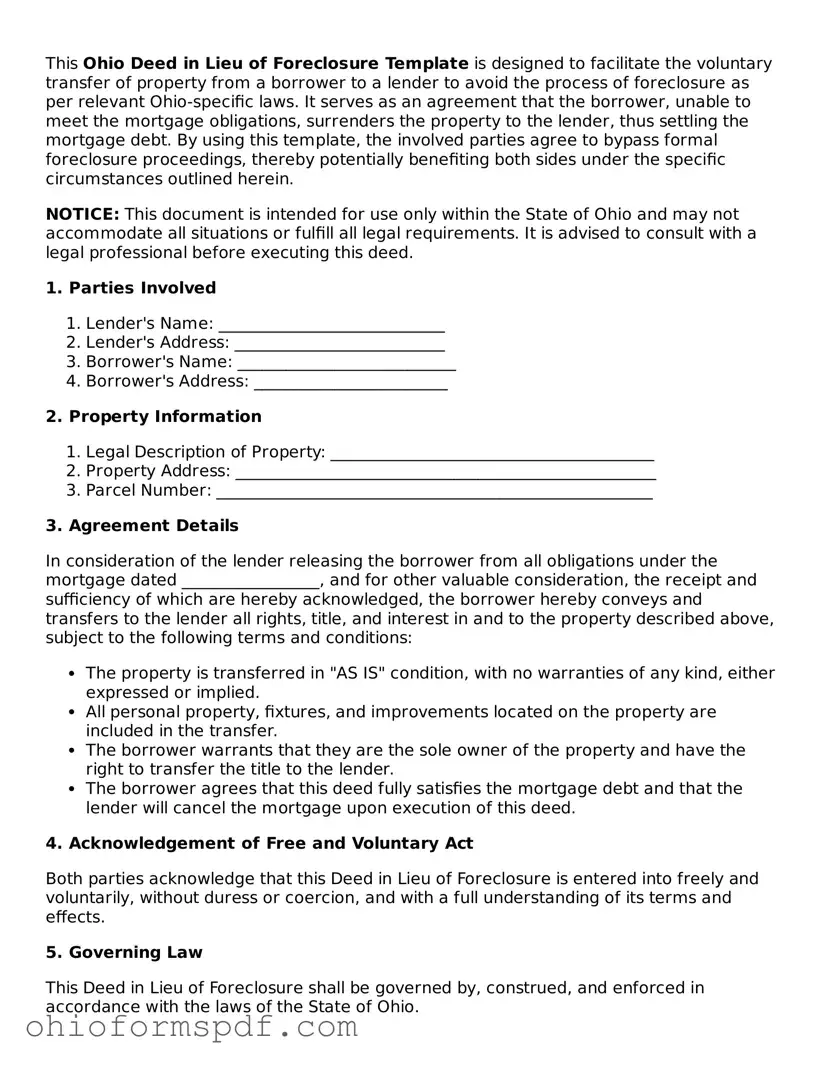What is a Deed in Lieu of Foreclosure form in Ohio?
A Deed in Lieu of Foreclosure form is a legal document in Ohio that allows a homeowner facing foreclosure to transfer the ownership of their property back to the lender voluntarily. This is often seen as a mutually beneficial arrangement, as it enables homeowners to avoid the consequences of a foreclosure, and lenders to more quickly reclaim the property without undergoing the lengthy and expensive foreclosure process.
What are the benefits of choosing a Deed in Lieu of Foreclosure over foreclosure in Ohio?
Choosing a Deed in Lieu of Foreclosure offers several benefits, including avoiding public foreclosure, potentially less damage to the homeowner’s credit score, and a quicker resolution for both the homeowner and the lender. It can also relieve the homeowner from the burden of outstanding debts tied to the property, though this depends on the specific terms agreed upon with the lender.
Are there any eligibility criteria for a Deed in Lieu of Foreclosure in Ohio?
Yes, there are specific criteria that must be met to qualify for a Deed in Lieu of Foreclosure. These generally include having a clear title to the property (no liens or other encumbrances), the consent of the lender to accept the deed in lieu of foreclosure, and in many cases, having attempted to sell the property at fair market value without success. Lenders may have additional requirements, so it's essential to check with them directly.
How does one initiate a Deed in Lieu of Foreclosure process in Ohio?
Initiating the process typically involves contacting your lender to express interest in a Deed in Lieu of Foreclosure. You'll likely need to provide financial information and evidence that selling the property at fair market value isn't feasible. The lender will review your situation to decide if accepting the deed is in their best interest. If they agree, you'll work together to prepare the necessary documentation, including the Deed in Lieu of Foreclosure form.
What documents are required to complete a Deed in Lieu of Foreclosure in Ohio?
In addition to the Deed in Lieu of Foreclosure form, homeowners will need to provide other documents as requested by the lender. These can include a financial statement, hardship letter, proof of income, property appraisal or market analysis, and any agreements on remaining debts after transfer. Exact requirements can vary by lender.
Can a Deed in Lieu of Foreclosure in Ohio clear all debts tied to the property?
Whether a Deed in Lieu of Foreclosure clears all debts tied to the property depends on the agreement between the homeowner and the lender. In some cases, the lender may agree to forgive remaining debts, known as a deficiency waiver. However, in other cases, the homeowner may still be responsible for certain debts. It's crucial to clarify this aspect during negotiations.
How does a Deed in Lieu of Foreclosure affect a homeowner's credit in Ohio?
While a Deed in Lieu of Foreclosure is generally less damaging to a homeowner's credit than a foreclosure, it still has a negative impact. It can lower credit scores and affect the homeowner's ability to qualify for loans in the future. The extent of the impact varies based on individual credit histories and other factors.
Is it possible to rescind a Deed in Lieu of Foreclosure agreement in Ohio?
Once a Deed in Lieu of Foreclosure agreement is finalized and the deed is transferred to the lender, it is typically difficult to rescind the agreement. However, if both parties consent or if there was a misrepresentation or other legal issue with the agreement, rescinding may be possible. It's important to consult with a legal professional to understand your options.
Where can I find help or more information about Deed in Lieu of Foreclosure in Ohio?
For help or more information about Deed in Lieu of Foreclosure in Ohio, consider consulting with a real estate attorney who is knowledgeable about foreclosure alternatives. Additionally, contacting your lender for guidance and exploring resources available from local housing counseling agencies can provide valuable assistance during this process.
